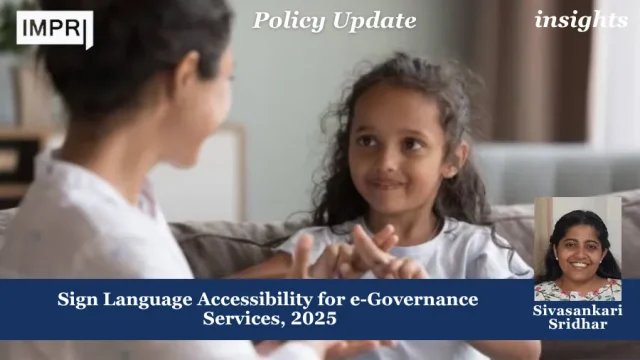Policy Update
Sivasankari Sridhar
Background
Digital governance in India has grown rapidly under the Digital India programme launched in 2015, which aimed to transform the country into a digitally empowered society and knowledge economy. A key component of this transformation is inclusivity, ensuring that every citizen can access public services without barriers.
However, persons with hearing and speech disabilities often face obstacles while accessing e-Governance services because most portals and applications do not provide content in Indian Sign Language (ISL). The Rights of Persons with Disabilities (RPwD) Act, 2016 mandates accessibility in information, communication, and services. Similarly, the Accessible India Campaign (Sugamya Bharat Abhiyan), launched in 2015, promotes digital accessibility.
The need for sign language accessibility arises from India’s large population of persons with hearing impairments, estimated at 18 million by the National Association of the Deaf. The objective is to ensure equity in governance, reduce exclusion, and align with India’s commitments under the United Nations Convention on the Rights of Persons with Disabilities (UNCRPD).
Functioning
The integration of sign language in e-Governance services is still at a nascent stage. Presently, accessibility provisions are guided by the Guidelines for Indian Government Websites (GIGW 3.0), which align with international standards like Web Content Accessibility Guidelines (WCAG). However, implementation varies across ministries and states.
Functioning includes
- Adding ISL videos on government portals to guide users.
- Providing virtual or tele-services with interpreter support.
- Using AI tools for real-time sign language translation.
- Setting up helpdesks with trained personnel in basic ISL.
Challenges include limited interpreter availability, lack of technical expertise in ministries, and uneven enforcement of accessibility guidelines.
Performance
In the last three years, initiatives like the Indian Sign Language Research and Training Centre (ISLRTC) have contributed to standardising ISL and training interpreters. A few government portals, such as those of the Ministry of Social Justice and Empowerment, have started uploading ISL video resources.
Despite this progress, performance remains limited. According to the CAG Report on Accessibility in Digital Platforms (2023), less than 15 percent of central government websites were fully compliant with accessibility norms. The Economic Survey 2024 highlighted that while internet penetration improved, persons with disabilities continued to face barriers in digital inclusion.
Budget allocations for disability welfare under the Department of Empowerment of Persons with Disabilities increased from ₹1,225 crore in 2022-23 to ₹1,325 crore in 2024-25, but spending on digital accessibility-specific interventions has not been disaggregated clearly.
State-level performance is uneven. Kerala and Tamil Nadu have piloted ISL-friendly interfaces, while many states are yet to adopt such measures.
Impact
The limited integration of ISL has slowed down the intended impact of e-Governance on inclusivity. Many citizens with hearing impairments still depend on intermediaries or family members to access services. This affects their independence, privacy, and dignity.
At the same time, small but significant impacts are visible. ISLRTC initiatives have expanded awareness about ISL. Pilot projects by some ministries show that ISL-supported platforms improve user satisfaction and increase uptake of services by persons with disabilities. Globally, examples from the United States and European Union demonstrate that accessible digital services enhance both trust in governance and efficiency of service delivery.
Emerging Issues
- Limited adoption of ISL across government portals and apps.
- Shortage of trained ISL interpreters.
- Low awareness among government officials about accessibility requirements.
- Budgetary allocations not clearly directed towards digital accessibility.
- Regional differences in implementation between states.
Suggestions
- Mandate ISL integration across all new e-Governance platforms.
- Invest in AI-driven sign language tools and captioning software.
- Expand interpreter training programmes through ISLRTC.
- Allocate dedicated funds for digital accessibility.
- Build awareness among government staff and citizens through workshops and campaigns.
Way Forward
Sign language accessibility must become a core component of India’s e-Governance vision. The objectives of Digital India cannot be fully realised unless every citizen, including persons with disabilities, can access public services independently. By aligning investments, technology, and capacity building, India can move towards inclusive governance where no one is left behind.
References
- Amrita Vishwa Vidyapeetham. (n.d.). Sign Language Accessibility for e-Governance Services. Retrieved October 12, 2025, from https://www.amrita.edu/project/sign-language-accessibility-for-e-governance-services/
- UMANG. (n.d.). Accessibility. Retrieved October 12, 2025, from https://web.umang.gov.in/landing/accessibility
- Nedungadi, P., Dileep, G., Geetha, M., & Raman, R. (2025). Vision transformer-powered conversational agent for real-time Indian Sign Language e-governance accessibility. Scientific Reports, 15(1), Article 33055. https://doi.org/10.1038/s41598-025-12667-3
- Author(s). (Year). Title of article. Journal Name, Volume(Issue), page range. https://doi.org/… (Note: I could not retrieve full metadata from the given URL: https://journals.sagepub.com/doi/full/10.1177/2158244013491405?utm_ .
- Author(s). (Year). Title of article. AJES [or full journal title], Volume(Issue), page range. Retrieved from https://ojs.trp.org.in/index.php/ajes/article/view/4132?utm_
About the Contributor
Sivasankari Sridhar is currently pursuing her bachelor’s in economics from Dr B R Ambedkar School of Economics, Bangalore and also is a research intern in IMPRI.
Acknowledgment: The author sincerely thanks the IMPRI team for their valuable support.
Disclaimer: All views expressed in the article belong solely to the author and not necessarily to the organization.
Read more at IMPRI:
National Institute of Electronics and Information Technology (NIELIT), 2011



















